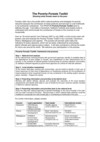The Poverty-Forests Toolkit: showing what forests mean to the poor
Forestry often has a low profile within national policies and strategies for poverty reduction because its contribution to rural livelihoods may not be sufficiently understood. The PROFOR-funded Poverty-Forests Toolkit aims to address this gap. It provides a framework, fieldwork methods and analytical tools to understand and communicate the contribution of forests to the incomes of rural households.
IIED worked with national and local level stakeholders in Cameroon, Ghana, Madagascar and Uganda to present, apply and evaluate the Poverty-Forests Toolkit.
The aim was to enhance the profile of forestry in poverty reduction strategies and other policy processes, and to refine the toolkit for future use in other countries.
What IIED did
The four country teams worked at the national level with forestry services, national statistical offices, poverty reduction strategy coordination offices and forestry universities, and at local level with forest-using communities and forest officers.
By developing analytical capacity, the project helped to inform data collection and enhance the profile of forestry in national policies and strategies for poverty reduction.
The project involved components of training, application, evaluation and uptake. The Poverty-Forests Toolkit combines national-level analysis (current data and data collection practices) with local-level participatory analysis at chosen sites (identifying communities’ use of and dependence on forest resources).
The results of these analyses were shared with national agencies to spread knowledge on the role of forests in the cash and non-cash incomes of the poor and explore options for reflecting these roles more effectively in statistics.
Publications
Partners
Cameroon World Conservation Union
Ghana Environment and Development Ltd
UK Overseas Development Institute and Centre for International Development and Training at the University of Wolverhampton
Donors
PROFOR (the multi-donor Program on Forests)
